![]()
It is strange seeing winter squashes beside watermelon at the farmers market. Eggplant and enormous turnips. Sweet corn and cabbage. Winter and summer mixed with colorful abandon—that’s what early fall is for. I couldn’t resist plunging for the pumpkins and winter gourds while picking up some tomatoes, too. We won’t have the latter in-season in the Northeast for much longer, but it’s a warm welcome to squash season, having the best of both worlds.
What a wild world it is in fall. This is many peoples’ favorite time of year, so much so that it’s become compulsory to hear this being said, right now. This past weekend was an incredibly beautiful one in New York City. It was sunny, but not too warm; there was a breast cancer awareness month walk in Prospect Park, and there were many peoples’ birthdays, too (did you know that October is the most popular month in the year for birthdays? Something about the boredom of the still of winter…).
And there were winter squashes stacked beside the watermelon at the Grand Army Plaza Greenmarket, just-picked gourds all the same (and if you weren’t careful, you might mistake a whitish melon for an heirloom pumpkin).
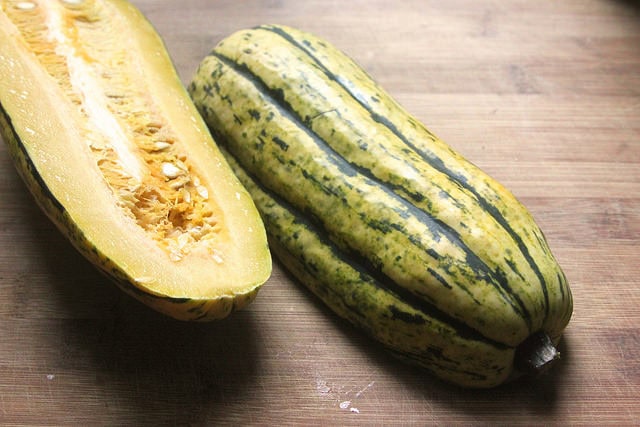
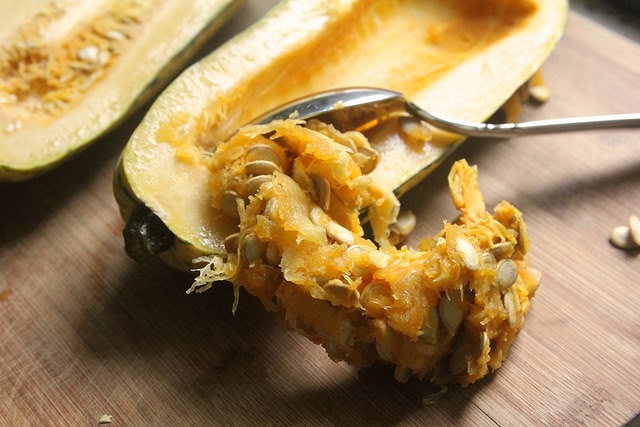
I didn’t make it to a pumpkin patch in the field last weekend, nor a fruit orchard to pick from either. But I did my share of picking—and consequently trucking back—more than an arm’s load of miniature sugar pumpkins soon to be candleholders for an upcoming dinner party. I hope you’re brewing up something similarly fun for an occasion, too.
And I grabbed a delicata squash, those oblong, ridged, yellow and lizard-green winter gourds that make fetching floral shapes when sliced lengthwise. But are also so quick and easy to roast halved—preferably stuffed with something tasty in their seed-scooped cavity.
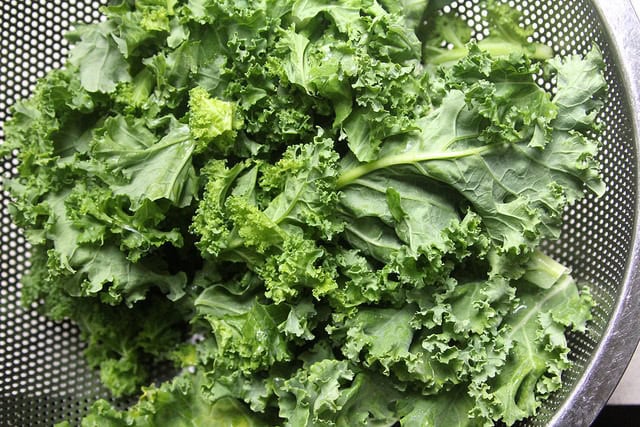
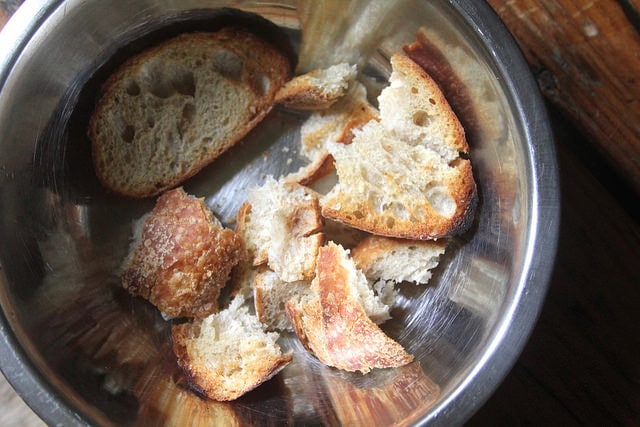
Stuffing of any type—whether it’s inside a bird or a vegetable—should be a repository for scraps to use up in the kitchen. Bits of flavorful things with stale bread, usually. The natural splendor of the vessel should still shine through. So I rummaged through my kitchen and found a half-used bunch of kale, some stale sourdough bread, sundried tomatoes, garlic, and some pinenuts in the pantry. Combined, it was a match made in heaven, as I found out later for lunch.
This is a healthful and surprisingly easy meal packed into an edible vegetable pocket. I dare you to try something wildly different stuffed inside a delicata squash next.
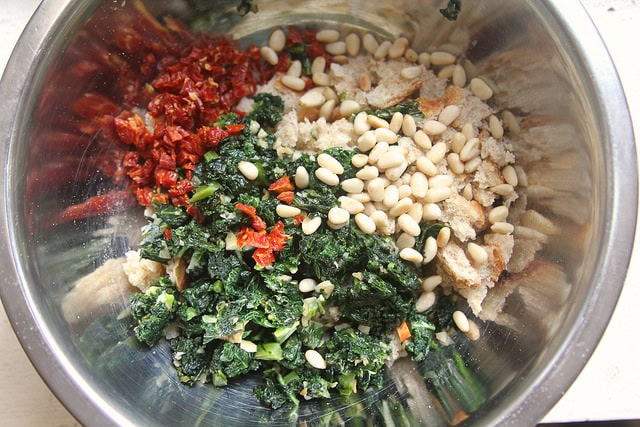
There’s a sweet-savory appeal to this dish thanks to the bright ochre gourd’s flavor, and of course, Vitamin A galore. You could even make a dessert out of something like this, and forsake pie pastry crust for a winter squash. Many farmers have even suggested this, over the years of shopping at the farmers markets and hearing their thoughts on what to do with smaller varieties of winter squash like delicata—aside from setting them on your table as decorations.
I have no qualms about decorating with winter gourds, but once your party is done, or you’re tired looking at them, miniature pumpkins and squashes are easy, (relatively) quick-cooking eats, too. All those warbly, witches’-warty-looking squashes included. Have no fear—cook them similarly to the preparation here. Delicata squashes just so happen to have an excellent ratio of flesh to skin and seed, perfect for cooking evenly.
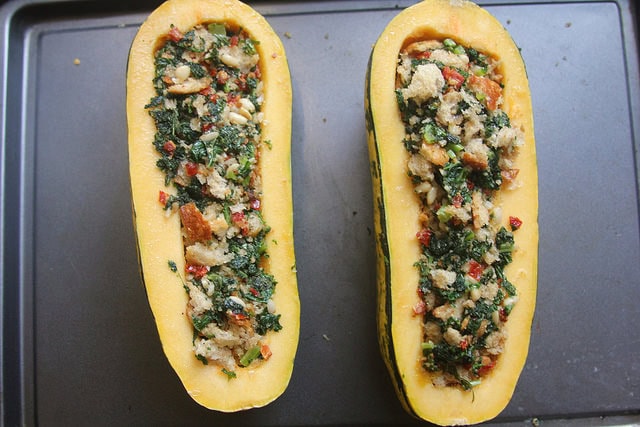
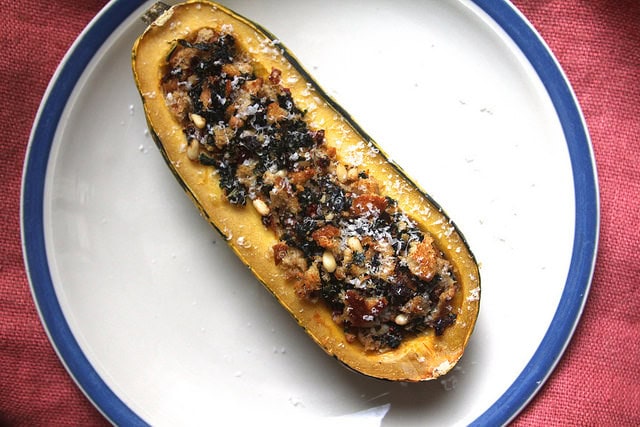
Plus, one stuffed delicata squash half makes a great individual-sized portion. A perfect fall lunch, as I’ve found. Sure, you could divide these up as side dishes, but there’s something nice about plopping the whole piece on your plate and eating it all up. It’ll make an impressive main course, that way—good for vegetarians at Thanksgiving. And the stuffing iterations are endless, much like the turkey’s. It also keeps in the fridge and reheats well. This ornamental dish, like the squash itself, is just as edible as it is lovely to look at. That’s what a great deal of things are like in fall.
Stuffed Delicata Squash with Kale and Pinenuts
(makes 2 large servings)
1 medium-large delicata squash (about 1.5-2 lbs)
¼ cup pinenuts
2-3 tablespoons extra-virgin olive oil
2 cloves garlic, minced
about ½ bunch kale (or 8 leaves), stripped of thick stems and chopped
2-3 slices stale, crusty bread, crushed to crumbs (some irregular-sized chunks are ok)
4-5 sundried tomatoes, finely chopped
salt and freshly ground black pepper
grated parmesan for finishing (optional)
Preheat oven to 350 degrees. Halve the squash and scrape out the seed pockets with a spoon.
Heat a dry pan and add the pinenuts to them. Shake the pan and cook for 1-2 minutes, or until the sides are just starting to turn golden, and remove them immediately from the heat, setting them aside in a bowl.
Add the olive oil, garlic, and kale to the pan, along with a pinch of salt and pepper. Cook, stirring occasionally, for 4-5 minutes or until the kale is fully wilted and most of its liquids have released and evaporated. Let cool several minutes, then transfer to a cutting board and chop finely.
Combine the breadcrumbs, pinenuts, sautéed kale and chopped sundried tomatoes in a bowl. Divide the filling amongst the two squash halves and press down into their scooped-out cavities. Place the squash stuffed side-up on a baking sheet and roast for about 35-45 minutes, or until the squash is fully cooked. Let cool a few minutes before serving, and sprinkle the tops with the optional parmesan for garnish.
Cost Calculator
(for 2 servings)
1.5 lb squash: $2.00
½ bunch kale: $1.50
2 pieces stale bread: $0.50
¼ cup pinenuts: $2.00
5 sundried tomatoes: $0.50
2 cloves garlic: $0.20
3 tablespoons olive oil: $0.50
Total: $7.20
Health Factor![]()
![]()
![]()
Three brownie points: If you’re looking to eat more vegetables than starches, this is a great idea. Rather than sandwiching a bunch of veggies between bread, this is a somewhat portable meal that’s encased in vegetable. That vegetable in question—winter squash—is a rich source of vitamins, like Vitamin A and C, and it has enough carbs to fill you up. The filling is packed with mostly plants, too, like the superfood kale for more vitamins and minerals like Vitamin K and iron. You can skip the bread entirely if you like, but a few pieces of crusty, crouton-like bread don’t add a bit of crunch and not much calorie.
Green Factor![]()
![]()
![]()
![]()
![]()
![]()
![]()
![]()
Eight maple leaves: Using up stale bread and in-season produce, this is a hearty meatless meal.
3 Responses
Love Food Life Alchemy
I love hearty squash recipes like this in the fall. Thank you!
Bing Search History Delete
Hey your creativity is really amazing, thank you for sharing this recipe. bing is the most usable browser in the world wide but someone was getting a trouble to remove in history, there suggest site is helping to clear in your web browser.
instagram
It looks so fun to make. Thank you for sharing the recipe. I have never heard of using kale and pinenut and squash.